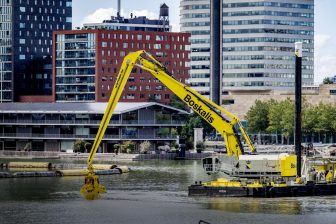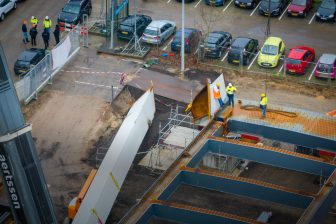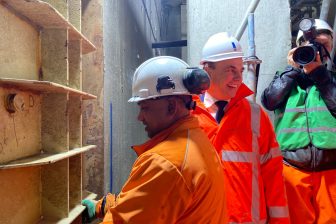Construction decrease W Europe, increase E Europe
Peak of the construction cycle has been passed in Western Europe – increased upturn in Eastern Europe
The 64th EUROCONSTRUCT conference organized by WIFO – the Austrian Institute of Economic Research is held on 23rd November 2007 in Vienna (Palais Ferstel). About 250 decision makers of the European construction sector are gathering from 25 different countries to discuss investment and business opportunities in future markets. The main focus is on trends and analyses of the European construction market and especially markets possibilities in Eastern Europe. EUROCONSTRUCT, the leading construction research network in Europe, presents twice a year detailed forecasts by sectors in 19 Euroconstruct countries based on a consolidated database. At the Vienna conference international experts discuss the future of the European construction markets until 2010 with special focus on Russia, Ukraine, Turkey, South-Eastern Europe as well as Middle East and Northern Africa.
The economic revival in Europe led to a boom in construction in 2006 which slightly weakened in 2007. The 3.8 % growth in real construction output achieved by the 19 EUROCONSTRUCT countries in 2006 fell to a more modest 2% in 2007. Growth in the construction sector is set to slow further, to 1.4% in 2008, and will only bounce back slightly in 2009 and 2010 by 1.6% per year.
In the boom year of 2006, the construction sector was a significant engine in driving the overall European economy. But over the period 2007 to 2010, its dynamism is set to dwindle by comparison with the growth in GDP. During the forecast period (2008 to 2010), the 19 EUROCONSTRUCT countries are estimating average annual growth in GDP of 2.3%, compared with a figure for the construction sector of only around 1.5%. Demand for construction is falling, especially in Western Europe, whilst in Eastern European countries the sector is enjoying increasing dynamism and becoming an engine for growth for the overall economy.
Different trends in construction in Western and Eastern countries
In Western Europe the construction sector has cooled down in 2007. The causes of the weakening economy for construction in Western Europe lie above all in the international financial crisis, the increasing strength of the euro, higher interest rates and the bursting bubble in real estate markets (notably in Spain, Ireland and Great Britain), and the fall in overall demand in the economy.
In line with the general upturn in the economy, construction industry grew particularly strongly in 2006. The strong profits situation encouraged many companies to invest, primarily in non-residential construction (mainly in industrial construction, retail construction, office construction and commercial premises). One consequence of the improved trend in the economy was that the greater tax revenues swelling public-sector budgets led to acceleration in public investment in infrastructure. The rapid expansion in demand for construction resulted in a fall in unemployment and an increase in jobs in the construction sector. Some countries are even complaining of a lack of specialist construction workers. In 2007, the construction sector in Western Europe has already cooled down markedly and growth rates have halved (2007: 1.7%). In 2008, real construction output is now forecast to increase by just 1%. The global crisis in the financial markets has resulted in a more cautious approach to investment in Western Europe. In addition to this, the downturn in the high price of real estate – particularly in Spain, Great Britain and Ireland – is putting the brake on demand for construction investment. The strong expansion in housing output is increasingly leading to over-capacities. Overall, Western European countries are predicting a moderate increase in construction output for 2009 and 2010 (1.2% and 1.3% respectively).
In Central Eastern Europe, unlike Western Europe, the construction upswing is set to strengthen over the forecasting period. Following increases in real construction volume of 7.7% and 7.6% (2006 and 2007 respectively), the construction sector will again expand vigorously by 9.2% in 2008 and this growth will only weaken slightly to 7.6% by 2010. Poland is exhibiting the greatest dynamism, with double-digit rates of growth. The construction sector in Slovakia is expected to grow more slowly, and the crisis in the Hungarian construction sector should be overcome in 2007. Growth in the Czech Republic is only likely to accelerate again to some extent towards the end of the forecast period.
Shift in trends within the construction sectors Analysis of the European construction market broken down across the individual sectors reveals an interesting shift within those segments. Whereas in 2006 housing construction still exerted key influence over growth in the overall construction sector, this segment becomes less important over the forecast period. The role as growth driver is now taken on by non-residential construction and by civil engineering. In Western Europe it is non-residential construction which is primarily driving growth. In Eastern Europe it is civil and – in this instance benefiting from subsidies from EU Structural Funds. The Eastern European countries are anticipating double-digit growth in 2008 – 2010. In addition, new housing construction is gaining in dynamism in Eastern Central European countries, as there is still a very significant catch-up requirement in these countries. Due to the high multiplier effects on employment and output, housing construction is playing a key role in the overall economic catching-up process in the new EU countries in particular.
U las zojuist één van de gratis premium artikelen
Onbeperkt lezen? Profiteer nu van de introductieaanbieding voor € 10,- per maand.
Bent u al abonnee?



